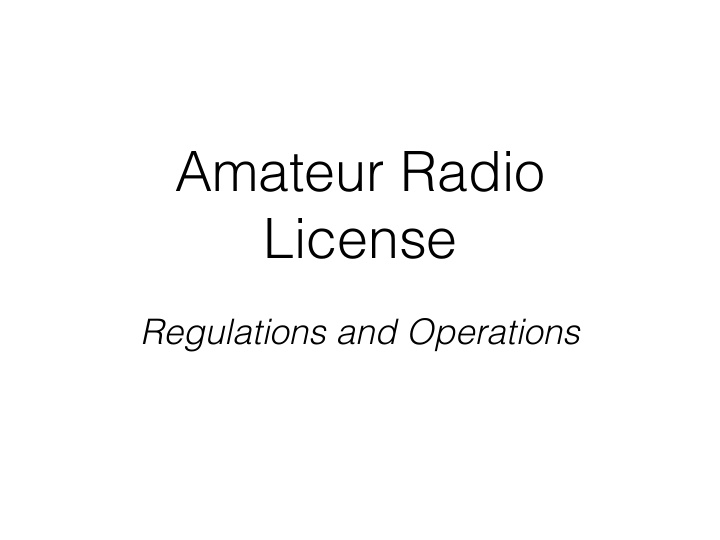



Amateur Radio License Regulations and Operations
FCC Registration Number (FRN) • Identifies you to the FCC • You need one to get a license • You can take the test without it (SS number works), but it is good to have, particularly if you don’t have a SS number or taxpayer ID • Google “FRN FCC”, and the top link will get you there.
Todays Topics • Pending changes in HF tech bands • Basic Regulations • Radio Signals and Fundamentals • Basic Operations
Technician Band Changes • Proposal to give tech’s access to HF bands for digital communications (FT8, WSPR, etc) • Approved by ARRL last summer • Pending with the FCC • Any tech band that was CW only is now open for digital modes
Basic Regulations
Amateur Radio (Official) • Amateur (or Ham) Radio is a personal radio service authorized by the Federal Communications Commission (FCC). • To encourage the advancement of the art and science of radio. • To promote the development of an emergency communication capability to assist communities when needed. • To develop a pool of trained radio operators. • To promote international good will by connecting private citizens in countries around the globe.
Licensing Authority • Federal Communications Commission (FCC) • Amateur Radio operations covered by FCC rules published in Part 97 of Title 47 – Code of Federal Regulations. • Use “Part 97” for short • Others are Part 90 (commercial), Part 95 (CB, MURS, FRS), and Part 15 (WiFi, low power, anything that radiates RF).
The Amateur License • No age limit or citizenship restrictions. • One exception – foreign representatives. • License actually contains two parts. • Operator License. • Station License (the Call Sign). • Three levels of operator privileges: Technician, General, Amateur Extra.
Exam • Multiple choice, multiple exams, multiple levels • Run by Volunteer Exam Coordinators (VEC) • At least 3 Volunteer Examiners (VE’s) of higher class • You can operate when your call sign appears in the FCC data base (www.wireless.fcc.gov/uls) and you have your call sign. Usually just a few days.
License Term • The license is free and good for 10 years. • Renewable within 90 days of the expiration date (2 year grace period). • Some personal identification information is required. • Tax ID (Social Security number). • Current Mailing Address. • Federal Registration Number (FRN).
Responsibilities • Prevent unauthorized operation of your station. • Provide personal information as required – keep a current mailing address on file. • Make your station available for FCC inspection upon request.
Basic Principles • You can’t make money from transmitting on amateur radio frequencies • Limited ads, no music, etc • You should be polite and cooperate with others • Minimum power necessary • Use accepted frequencies appropriately • No encryption • Amateur radio is basically self regulated
Which of the following is a purpose of the Amateur Radio Service as stated in the FCC rules and regulations (T1A01) A. Providing personal radio communications for as many citizens as possible. B. Providing communications for international non- profit organizations C. Advancing skills in the technical and communications phases of the radio art D. All of these choices are correct
Which of the following is a purpose of the Amateur Radio Service as stated in the FCC rules and regulations (T1A01) A. Providing personal radio communications for as many citizens as possible. B. Providing communications for international non- profit organizations C. Advancing skills in the technical and communications phases of the radio art D. All of these choices are correct
What agency regulates and enforces the rules for the Amateur Radio service in the United States? (T1A02) A. FEMA B. The ITU C. The FCC D. Homeland Security
What agency regulates and enforces the rules for the Amateur Radio service in the United States? (T1A02) A. FEMA B. The ITU C. The FCC D. Homeland Security
Radio Signal Fundamentals
Finding Where You are on the Radio Dial • Described as Band, Frequency, or Wavelength • Bands: HF, UHF, VHF • Frequency: 50 MHz, 144 MHz, 440 MHz • Wavelength: 6 m, 2 m, 70 cm • Wavelength (in m) = 300 / (frequency in MHz)
Recommend
More recommend